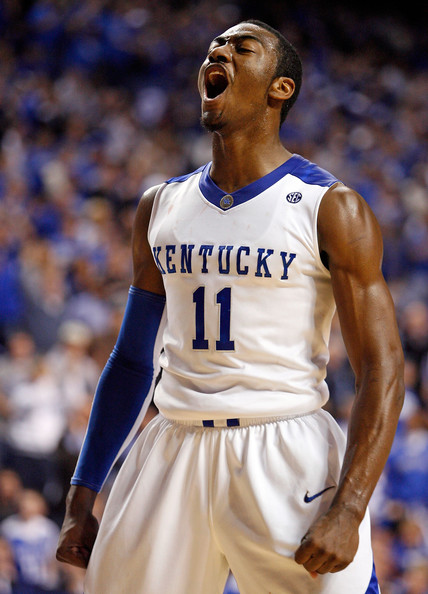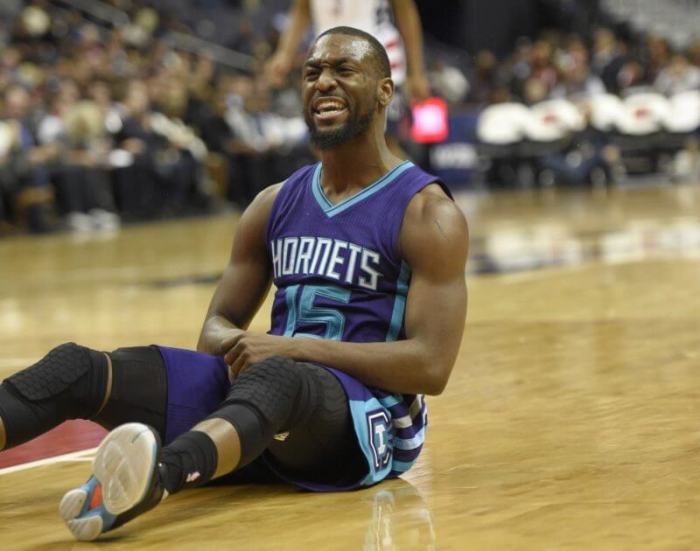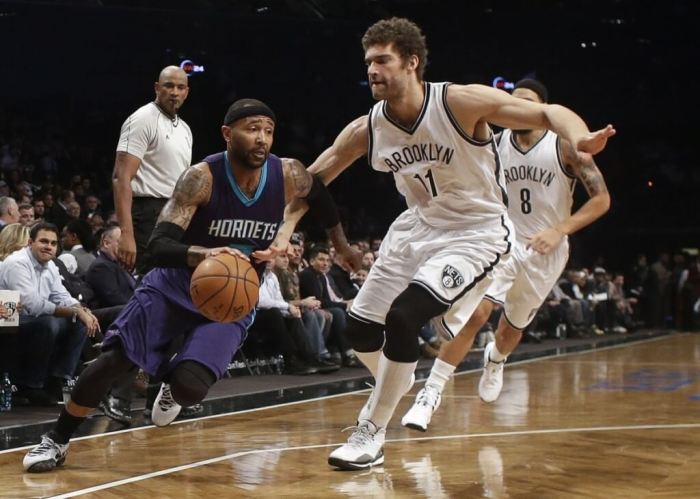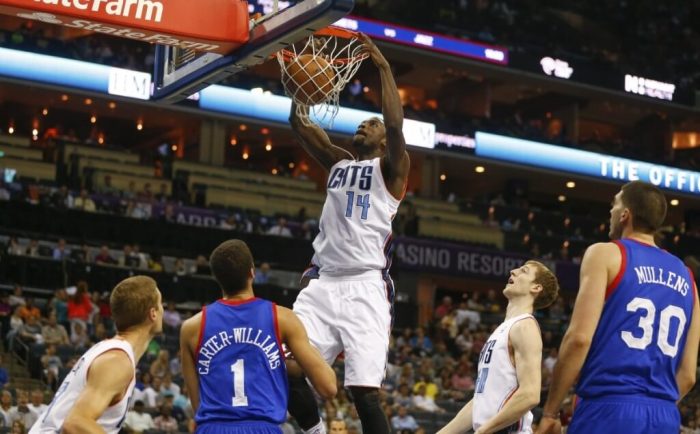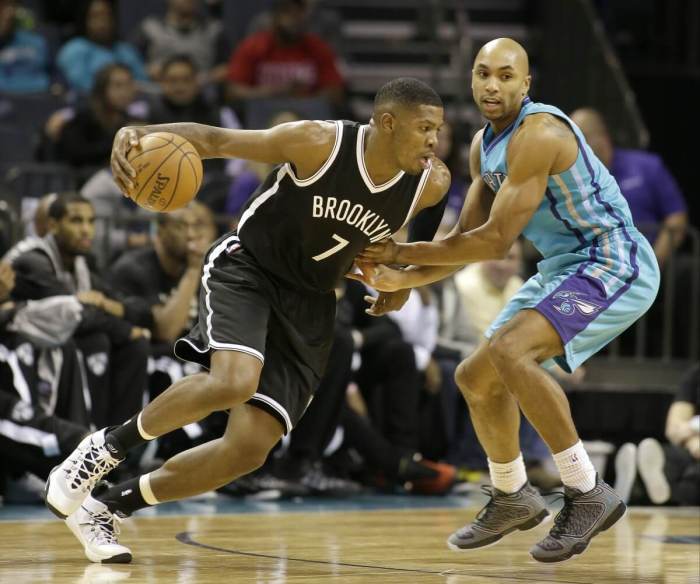As far as the future goes, only two things are for certain: a) the Nets will have a top four pick in the draft this coming summer, and b) a lot of cap space. Everything else is in flux. No one (save Brook Lopez and Mikhail Prokhorov) is untouchable. Because the Nets have the best chance of getting the #1 pick (25% to be exact), one of the more exciting topics that Nets fans have is centered around who the Nets should take if they end up getting it. There are two obvious candidates – Kentucky freshman point guard John Wall, or Ohio State junior swingman Evan Turner.
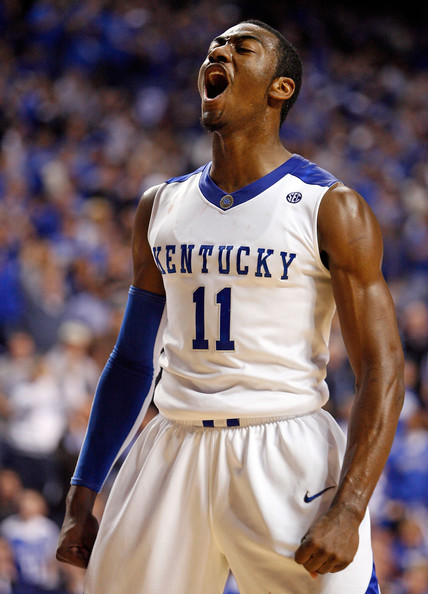
Evan Turner is an awesome basketball player. John Wall is the #1 pick.
This is probably a little premature as a Nets fan – after all, we only have a 25% chance of the first pick – but this analysis could apply to nearly any team who would pick number one. I’m only going over who is the best prospect. I originally was on the Turner bandwagon, and switched back and forth a few times throughout the season. The original title for this post was “John Wall or Evan Turner?” until I realized that my argument was going decidedly in one direction.
That being said, don’t get me wrong. Evan Turner is an excellent basketball player and will continue to be at the next level. He’s a great rebounder for a swing man, has an excellent midrange and slashing game, is a willing defender, runs the floor like a gazelle, and can carry a team (as proven with Ohio State). He’s as close to a future star at the NBA level as you can get. Unless, of course, your name is John Wall. & For the next two thousand-plus words, I’m going to tell you why.
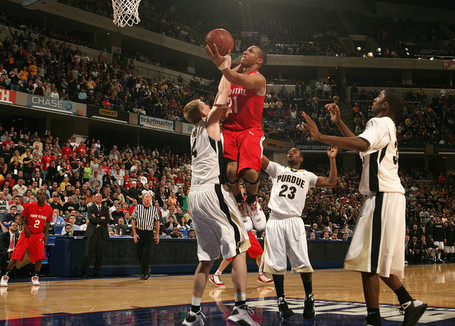
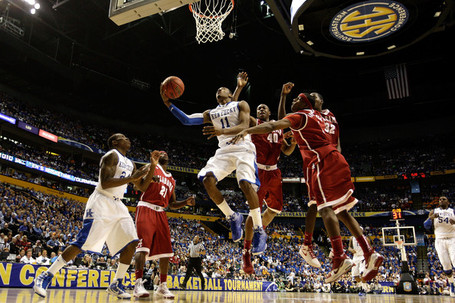
The two best prospects in the NCAA. The future of professional basketball.
1) John Wall is the single best athletic specimen the league has seen since Dwight Howard or LeBron James. Yes, everyone talks about this. Yes, it’s boring and repetitive to mention. There’s a reason people mention it. Because it’s freaking true. Chad Ford calls him extraterrestrially athletic. Jonathon Givony merely calls it freakish. Whatever you call it, it’s there, and barring a catastrophe of Len Bias proportions, it ain’t leaving. We all thought Derrick Rose was an athletic gift from God, and one year later the basketball deities bless us with someone who arguably blows him out of the water. Evan Turner is a solid athlete – he’s got an NBA-ready body, takes extremely long strides and has great size for the SG position – but he’s nowhere near the athlete that John Wall is. In today’s continually evolving NBA game, athletic ability means more and more every year.
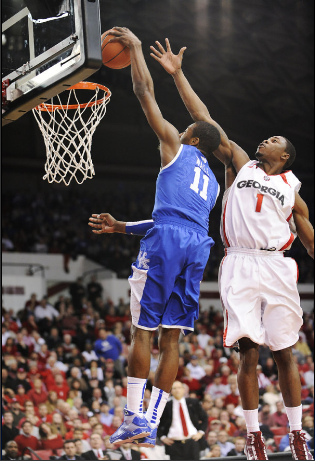
Words can’t describe how awesome this dunk was. Hopefully video can. (Or slow-motion video, too.)
No matter how you judge athleticism, Wall isn’t just off the charts – he’s past the moon. Leaping ability? The guy’s listed at 6’4″* and can dunk with two hands off an unguarded step. Lateral quickness? The guy can stay in front of anyone on defense, and even if he gets beat going in one direction is still able to recover and stay in front of his man. Although Kemba Walker actually makes this shot, you see an example of this here. End-to-end speed? There are about a hundred videos on YouTube showcasing that, so I figure one that also shows his change-of-direction speed (and leaping ability, for that matter) would be a better choice – many of you have probably seen this one before. Physical tools? He can finish with either hand, is chiseled, and has arms that stretch further than any point guard in the NCAA. Seriously. He’s got to have at least a 6’9″ wingspan. (Note: Wall’s wingspan, as measured at the combine, is 6’9.25″. Evan Turner’s wingspan? 6’8″. Told you.) Next time you see him play, watch how far his arms extend on defense. Or don’t, just look at the picture below. I think it provoked a lot of those early Dwyane Wade (who has a 6’11 wingspan) comparisons, when people were still figuring out whether or not he was a point guard.
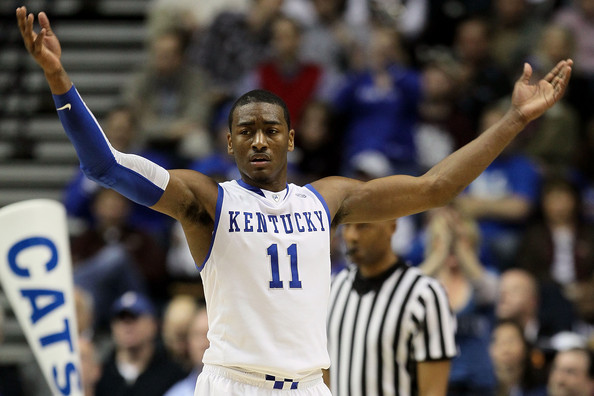
I want to say something clever about how long his arms are, but doesn’t this just speak for itself?
Luckily, that leads into my second point, which is:
2) John Wall’s feel for the point guard position is sublime for someone with his pedigree and ability to score. Let’s step back for a second. This is a guy who dominated high school basketball as an individual. He came to Lexington knowing he was likely the #1 pick in the NBA draft on potential unless he snoozed away his entire season. He could have spent most of his time jacking up shots and playing up his star status. Instead, here’s a guy who’s fourth in the NCAA in assists per 40 (pace adjusted). The guy averages a tick under 13 shots per 40PA – far from chucker level. Unless the game is on the line, you don’t see him forcing the issue. When Wall brings the ball up the court, there’s no worry about whether or not the point guard’s going to go into 1-on-5 mode (unless he’s really got a lane, and in that case, who would stop him? Not John Calipari, not his teammates, and definitely not Rider). He’s more Rajon Rondo than Allen Iverson. He’s shown an ability to be coachable (minor spat with Calipari aside) and understands that working within a team system doesn’t confine his talent, it explores it.
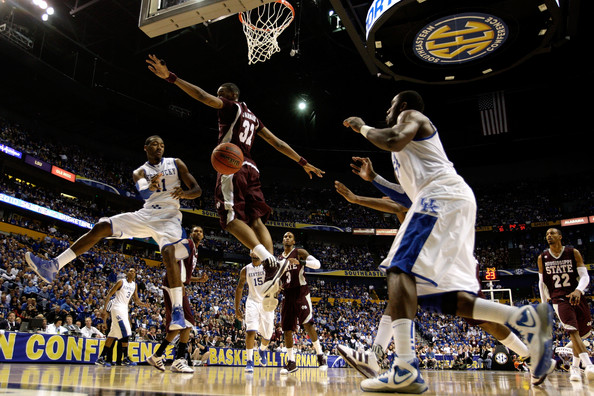
Beautiful drive and dish. Just like mom used to make.
Speaking of coachable…
3) John Calipari is known for developing point guards in college that excel in the NBA. Derrick Rose, Tyreke Evans. Calipari is kind of a sleazeball so that’s all I’ll say before this article gets removed from the record books.
4) John Wall’s college statistics are excellent for a point guard. One of the major arguments for Evan Turner in the “who should go #1” discussion is that his college stats blow Wall’s out of the water – and, to an extent, that’s a very valid point. Evan Turner is putting up raw figures that dominate any and all competition in the NCAA. The man is a legitimate triple-double threat every single night – 20 points, nine and a half rebounds and six assists per game are absolutely monstrous numbers. We haven’t seen anything like it since Larry Bird. The fact that he only turned it up in the Big Ten Tournament is an excellent indicator as well.
The issue with this argument, however, is that great point guards in the NBA often do not dominate statistically at the NCAA level. Wing players like Adam Morrison** are a dime a dozen in the pros, yet if you looked solely at his raw statistics at Gonzaga you’d convince yourself that he was the next Bird.*** Empirically, Wall can’t compete because the college game doesn’t reward great point guards with adequate statistical representation.
For example, let’s look at some great point guards drafted in the last decade and their raw numbers in college.
Chris Paul – 15 ppg, 6.3 apg, 4.5 rpg, 47.2 FG%, 2.5 spg in 33.5 mpg over two basically identical years
Deron Williams – 11 ppg, 5.9 apg, 3.3 rpg, 42.2 FG%, 1.1 spg in 31.7 mpg over one “rookie year” and two years of about 13pts/6ast in 33-34 minutes
Rajon Rondo – 9.6 ppg, 4.2 apg, 4.5 rpg, 49.3 FG%, 2.3 spg in 28.1 mpg over two seasons (little better his second year, although is percentages went down)
Derrick Rose – 14.9 ppg, 4.7 apg, 4.5 rpg, 47.7 FG%, 1.2 spg in 29.2 mpg in one year
Devin Harris – 14.8 ppg, 3.1 apg, 4.1 rpg, 44.7 FG%, 1.7 spg in 35 mpg over two decent years and a breakout junior season
Tyreke Evans – 17.1 ppg, 3.9 apg, 5.4 rpg, 45.5 FG%, 2.1 spg in 29 mpg in one year
And,
John Wall – 16.6 ppg, 6.5 apg, 4.3 rpg, 46.1 FG%, 1.8 spg in 34.8 mpg in one year.
Wall posts the second-highest scoring average, the most assists, near the bottom in rebounds (0.2 behind three guys), and middle-of-the-pack in field goal percentage and steals, while taking on a much higher load minutes-wise and reliance-wise than any other player (although, to be fair, none of these guys had a college big like DeMarcus Cousins to defer to). These numbers aren’t contextualized at all, though, so let’s look at per-40 pace adjusted stats from each player’s freshman year.

It’s a little small, so click & view the image itself to see the full-sized chart. Wall scores at the third-highest rate (behind Rose and Evans – the other two Calipari products), dishes out the most assists, turns the ball over a lot (turnover numbers basically increase as the years progress), commits the fewest fouls, and otherwise falls in the middle/top half of the pack. Note also that his rebounding totals look much better when contextualized in this manner. While there’s more context to be found here – the systems each team ran, for example, are very different outside of the Calipari 3 – it’s safe to say that between the change in hand-checking rules, the NBA’s defensive three seconds rule, quicker possessions at the NBA level, and much wider spacing, star point guards at the collegiate level find stats much easier to attain in the pros than in the amateurs, and a guy with Wall’s combination of basketball IQ and athleticism is the prototypical point guard to dominate because of these changes.
Now, of course, this goes both ways. Mike Conley had somewhat decent stats in college and has hit a wall in the NBA. Raymond Felton similarly looked pretty solid at UNC. This is where you really have to look a little past the numbers; Felton was a short point guard on a stacked college team, Conley wasn’t nearly as assertive on either end of the floor & and while impressive athletically didn’t have nearly the athletic potential that Wall exhibits on a nightly basis.
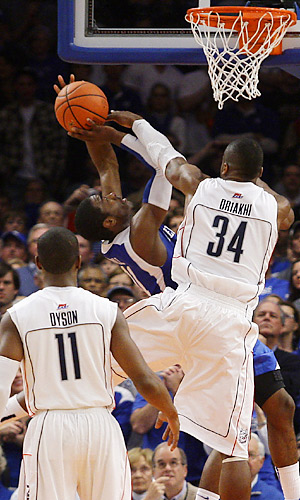
Midair body control. Nobody beats the Wall. (Dick Vitale agrees.)
5) John Wall’s blend of basketball ability and athletic ability is unmatched at the amateur level. For me, this really comes down to his ability to absorb contact and finish in traffic. His body control – evidenced by shots such as the one above that reminded Dick why he loves March Madness, and this ridiculous shot against Tennessee – is unbelievable for a point guard. Hell, for any position.
Just as important as anything else, though, is his sublime sense of the moment. We all heard the stories of how he hit clutch shot after clutch shot to start the season, but that underscores his true ability to rise to the occasion. Let me show you an example. The Louisville-Kentucky game – “The Bloodbath” – was a game where tensions ran high throughout. The first substitution happened seven seconds in, when Eric Bledsoe was replaced after arguing an early foul call. There were six fouls and three technicals assessed before there was a single shot attempt by either team. (Seriously.) DeMarcus Cousins was hit in the crotch and retaliated by elbowing the assailant in the face. It was not exactly what you’d call a graceful affair. Kentucky & Louisville both smelled blood, and they wanted a taste. With 9 and a half minutes to go in the second half, the score read 42-41 Louisville, and that’s when John Wall took over.
He starts off the show with a pump fake, getting his man (Louisville guard Edgar Sosa) off of his feet and flying past him. He drives to the hoop, hangs in midair for a seemingly impossible amount of time, gets off a shot at a ridiculous angle with two help defenders in his face, and somehow banks it in. 43-42 Kentucky. After Sosa turns the ball over on the next play, Wall receives a pass in the corner, evades Jerry Smith playing in the Louisville zone, and pulls up on the run from 17 feet. Swish. 45-42 Kentucky. Wall, feeling the momentum, picks Pedro Silva’s pocket on the next defensive play, leading to a near behind-the-back layup from Wall (the one that’s become his trademark) stopped only by a hard foul. Wall coolly hits the two free throws, puts Kentucky up 47-42, and Louisville never really threatened again.
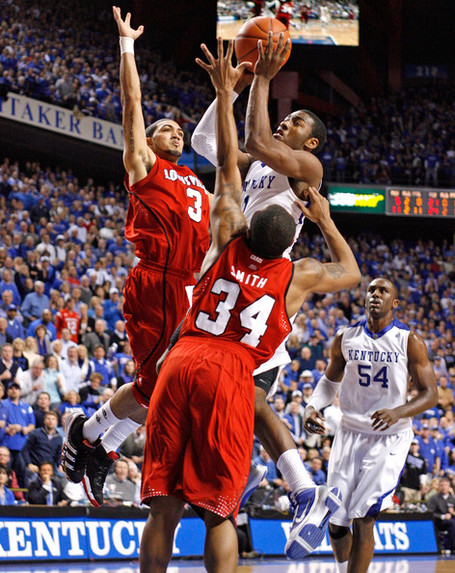
“I talked about his poise and his presence, Verne. You’re seeing his presence now.” – Clark Kellogg
When it comes down to it, there aren’t any prospects that match Wall’s combination of athletic ability, basketball smarts, feel for position, sense of the moment, & potential. Evan Turner comes closest, and he’s still more of a question mark. Will he be as effective in a system not built around him? We point to his unbelievable stats (and he deserves credit for them), but he also plays on a team with no real point guard and nobody who can rebound. As the unquestioned alpha dog and a pretty good rebounder/passer already, it’s no surprise that he focuses on getting them. Getting 10 rebounds a game as a wing is pretty remarkable – okay, it’s flat-out incredible – but had Jared Sullinger (the best rebounder in this year’s high school class & a future Buckeye) joined Ohio State this year instead of last year I think you’d see a downtick in those raw numbers.
All in all, I know I’ll get some argument because a fair amount of people here love Turner (and even Cousins), regardless of what or how much I write. That being said, I see Turner as a future star in the mold of a lower-middle-class man’s Brandon Roy or Scottie Pippen. He’ll sill be a great player and he’s worthy of the #2 pick in this draft. But John Wall combines the best aspects of Rajon Rondo with Kevin Johnson and Derrick Rose. He really has no equal. The hype is not undeserved, the praise not unwarranted. He really is just that good.

Both sides of the floor with the game on the line.
For me, there’s really one comparison that lines up cleanly with these two guys. When I was fourteen, there were two players that were being strongly considered for the #1 pick. Both big guys. The first guy was a high school kid, lauded as a hyperactive, jump-out-of-the-arena freak. He was described as “athletic and fluid” by NBA.com. Chad Ford of ESPN.com said he had “the most upside in the draft” and a “great attitude.” The other player, a three-year collegiate, had just come off a monster season – 16 points on 60% shooting on one of the best teams in the NCAA, 11 boards a game, a “physical specimen” and “aggressive rebounder” who played intelligent basketball with a tough work ethic.
I had convinced myself that the collegiate was the definite pick to make. It was obvious to me – you pick the proven beast. So when I found out that the Orlando Magic had selected – you guessed it – Dwight Howard over Emeka Okafor****, I thought the Magic had made the biggest mistake of their young franchise. I reamed it as much as a fourteen-year-old could. My dad got sick of me talking about it, and he’s my dad. I even became a Bobcats fan and played as them on NBA Live just to make sure Okafor would always have a higher rating. (It’s okay. I’ve since switched to 2K.)
But, of course, Howard became the all-world player, the top center in the league and the best player on a legitimate championship contender. Okafor, while a serviceable center, has never really capitalized on that talent, becoming a legitimate, consistent double-double threat but never a game-changer like Howard.
So I was wrong.
Very wrong.
And I won’t be making that mistake again.
__________________________________________________________________________
asterisk (*) notes
*-I wouldn’t be surprised if come combine day Wall actually lists an inch or two shorter. Just a hunch, though.
**-I want to make clear that I am in NO WAY SAYING that Turner is going to end up like Adam Morrison. At all. He’s got one thousand times the talent that Morrison has ever had. I think he’s going to be a legitimately great NBA player. Just that stats at the collegiate level can be easily misinterpreted if not adjusting for context.
***-Unfortunately, so did part-owner, part-pseudo-GM Michael Jordan, and he inexplicably picked Morrison third – the pick MJ himself was selected with 22 years earlier. I was sixteen and I knew this was an awful idea, but once you’ve drafted Kwame Brown first overall, you’re weirdly bulletproof – no bust is gonna top that. Weird thing is, Morrison got a ring earlier in his career than Michael did. You can’t make this stuff up.
****-The comparison between Okafor and Turner is seriously weird. Two guys, both juniors in college, both great scorers and rebounders at their position, both winning outstanding player awards in their junior year (Turner for the season, Okafor for the tournament), & both likely #2 picks behind guys whose wingspans, length and upside could put Jay Bilas in an adjective coma. But the crazy part? Both suffered back fractures in their junior years. Yup. Talk about a verifiable WTF. Now don’t get me wrong, I’ll take any odds (ANY!) that Turner is going to have a more successful career than Okafor, who’s been plagued his whole career with bad ankles and good buffets. But it is something to think about.
When I kept the links with the pictures, it screwed up the way they looked. Photo & other credits:
Pictures 1-6, 8 thanks to zimbio.com. Absolutely awesome site for basketball photos (and photos in general). Picture 7 thanks to courierpress.com. Picture 9 thanks to ukbigbluenation.com. All collegiate stats from draftexpress.com, the single best NBA draft website on the net.

